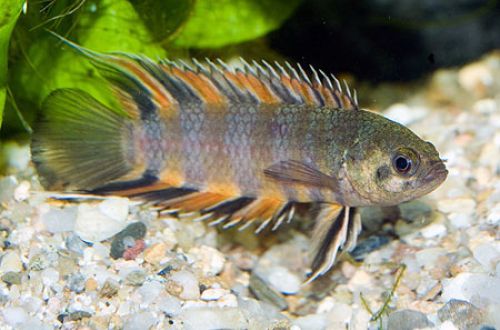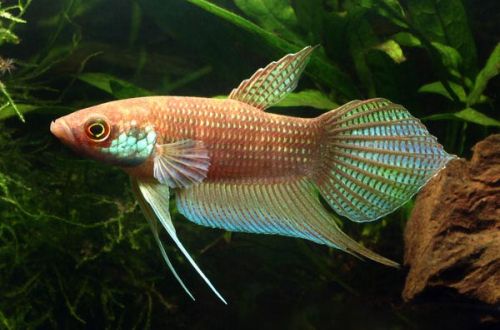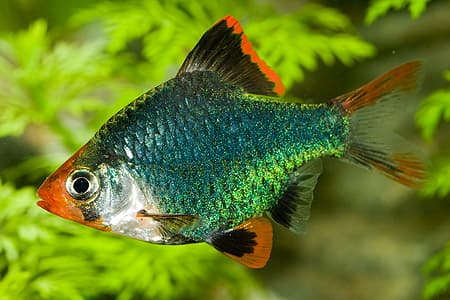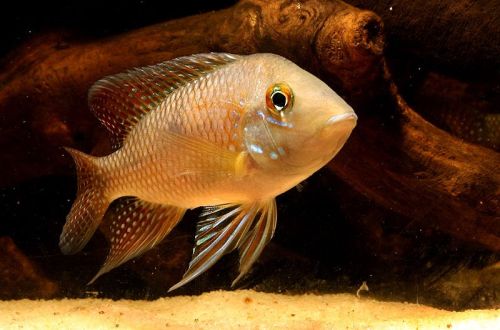
Exquisite Ctenopoma
Ctenopoma Ansorg or Exquisite Ctenopoma, scientific name Microctenopoma ansorgii, belongs to the Anabantidae family. Relatively peaceful calm fish with a bright contrasting body pattern. Easy to keep if live or frozen food is not a problem for you.

Contents
Habitat
It comes from the African continent from the Congo River basin from the territory of the modern states of the Republic of the Congo and the Democratic Republic of the Congo. Wild populations have also been noted on the island of Madagascar. They are found everywhere in various biotopes from open rivers along the coastline with dense vegetation to wetlands.
Brief information:
- The volume of the aquarium – from 80 liters.
- Temperature – 20-27°C
- Value pH — 5.0–7.5
- Water hardness – soft to medium hard (5-20 dGH)
- Substrate type – any
- Lighting – subdued
- Brackish water – no
- Water movement – any
- The size of the fish is up to 7 cm.
- Food – meat
- Temperament – conditionally peaceful
- Keeping alone or in pairs male / female
- Life expectancy – up to 5 years
Description
Adults reach a length of about 7 cm. Males are brighter colored than females, with proper lighting a contrasting pattern of alternating wide dark gray and orange vertical stripes that continue on the fins appears. The tail is rounded, the dorsal and anal fins are pointed and stretch almost along the entire body.
Food
The basis of the diet should consist of frozen or live food of a suitable size. Dry and freeze-dried food is used only as a supplement. It is worth noting that some breeders have successfully accustomed Ktenopoma Ansorg to certain types of dry food, so when buying, check the diet of the future pet.
Maintenance and care, arrangement of the aquarium
Maintenance and preparation of the aquarium is quite simple and does not require large financial costs. The minimum volume of the tank for one pair of fish starts from 80 liters. The design is arbitrary, subject to the following conditions – dense thickets of plants, including floating ones, and a subdued level of illumination.
The hydrochemical composition has slightly acidic pH values in a wide range of hardness. It is recommended to use a filtration system with a peat-based filter that can additionally acidify the water.
The presence of a lid not only provides a layer of warm, moist air necessary for the breathing of labyrinth fish, but also prevents accidental jumping out of the aquarium.
Maintenance comes down to regular cleaning of the soil from organic waste and weekly replacement of part of the water (10–15% of the volume) with fresh water.
Behavior and Compatibility
Peaceful calm fish, perfectly combined with other species of similar size and temperament. It is worth noting that overly active neighbors can force Ctenopoma away from the food source, so avoid this combination.
Intraspecific relationships are built on the dominance of the male in a certain territory. In small aquariums, skirmishes between them are not uncommon, competition is especially acute during the breeding season. Optimal conditions are achieved with a pair or harem content.
Breeding / breeding
The appearance of offspring is quite possible in a common aquarium, however, in the presence of other species, the survival rate of fry will be very low if they are not transplanted in a separate tank with identical water conditions in time.
Spawning can begin at any time during the year. The most favorable conditions for reproduction are achieved at acidic pH values (about 5.0) and very dim lighting. With the beginning of the mating season, the male builds a small nest of air bubbles in clusters of floating plants or under the surface of a wide leaf. At the end of construction, a female is invited to the nest, after a kind of mating dance, the female lays up to 600 eggs. The incubation period lasts about 24 hours, after another 2-3 days the fry begin to swim freely around the aquarium in search of food – this is the most convenient moment to transplant them, otherwise they will become easy prey for other fish, and in some cases their own parents.
Fish diseases
The main cause of most diseases is unsuitable living conditions and poor-quality food. If the first symptoms are detected, you should check the water parameters and the presence of high concentrations of hazardous substances (ammonia, nitrites, nitrates, etc.), if necessary, bring the indicators back to normal and only then proceed with treatment. Read more about symptoms and treatments in the Aquarium Fish Diseases section.





